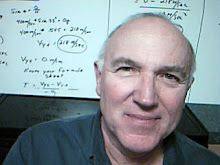Teaching high school physics in a vocational high school demands a "student hands-on" approach. My kids by nature tend to be "doers' more than "theorists" and as soon as I complete my 15 minute lecture, they are ready to try and prove the theory wrong or right. Therefore, it is understood that constructionism is a necessary tool in my educational arsenal. But, if "Contructionist Theory" , sounds familiar, it is because you may have heard it before under the name "Inquiry Based Learning". From "Concept to Classroom" (see URL below):
"The inquiry approach is more focused on using and learning content as a means to develop information-processing and problem-solving skills. The system is more student centered, with the teacher as a facilitator of learning. There is more emphasis on "how we come to know" and less on "what we know." Students are more involved in the construction of knowledge through active involvement. The more interested and engaged students are by a subject or project, the easier it will be for them to construct in-depth knowledge of it. Learning becomes almost effortless when something fascinates students and reflects their interests and goals."
Contructionist Theory also emphasizes a scaffolding approach. A building of a foundation before worrying about the roof. Therefore, the theory is as much a teaching of a logical approach to a problem as it is seeking a solution to a particular problem using the latest and greatest tools. In fact, we must not focus on the tool themselves, but we must teach that there may be solutions using a variety of tools, old and new. Focusing on MS Excel in 2010, as an example, might be as useless as focusing on the slide rule in 1970. Today's tools will pass as they are replaced by new tools, but the logical approach to a problem is timeless. That's the "take home lesson" I hope I am teaching my kids.
In my class we perform a great end of the year lab. The classic "Egg Drop Lab". Armed with momentum and impulse theory, my kids must drop an egg from a second story window without harming said egg. They are given: a zip lock bag; three straws; a sheet of newspaper; a meter of string; and a empty egg carton. Working as teams, they can construct whatever they choose with the material and they can perform as many dry run experiments as they would like in the 100 minute double period, but when they are ready, there is only one egg that must survive. Finally, the kids must note all iterations of their constructions as an engineer would document his theories and success/failures in a lab book. They must also theorize why their design failed and what they would do differently. They must scaffold….construct, a solution using any tools available. For the most part, they enjoy the exercise and as a result construct great solutions just as are readings predict they might. But, as with all “pros” we must guard against the “cons”. With diversity and inclusion, we are dealing with a wide range of abilities. When we allow are kids to work as teams and use either “self inquiry” or teamed “Constructionism”, there will be those who do enjoy the task at hand and those that would still rather be elsewhere. Without careful monitoring, there will be leaders and followers and others merely along for the ride.
Finally, I have been experimenting with voice threads as a tool to assist home- bound student and parents attempting to assist their kids. The attached is not a final version. I am still trying to get use to the program. But,I would still like yor feedback. Remember, it is not intended to be a lesson, but to augment a lesson. http://voicethread.com/#q.b875224.i4660550
Concept to Classroom
http://www.thirteen.org/edonline/concept2class/index.html
skip to main |
skip to sidebar

A posting of issues that matter to teachers.

About Me
- John Chaco
- Teaching physics is my second career. My first career was engineering and while I enjoyed that career, teaching has been all I could have imagined and more. In fact, I often see many of my old colleagues and when I do, I start recruiting. We need good teachers. I live in Connecticut and teach at a high school in Milford. I am married with three children and six grand kids.



John, I could not access the voice thread. I just registered. I am excited to hear it. I never took Physics. It frightened me to do so after my horrible experience with Chemistry. The egg drop lesson is great. What other hands on lessons do you do?
ReplyDeleteJohn--
ReplyDeleteI commented on your discussion post regarding the egg drop experiment that you have your students complete. I did want to tell you that I really like the way you explained scaffolding in your blog post. I never really thought of it in terms of actually building a foundation and a framing walls as one does when building a house. The idea that one does not have to worry about the "roof," or end product also made me think differently about how to get students from point A of understanding and logical thinking to point B on down. Concentrating on one step of the learning process at a time is sometimes what I have to do in order to get my students all on the same page when discussing a difficult concept in history and psychology.
Thank you for your thoughts.
Courtney